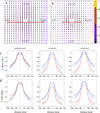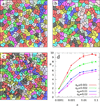Collective cell streams in epithelial monolayers depend on cell adhesion
- PMID: 24363603
- PMCID: PMC3866308
- DOI: 10.1088/1367-2630/15/7/075006
Collective cell streams in epithelial monolayers depend on cell adhesion
Abstract
We report a spontaneously emerging, randomly oriented, collective streaming behavior within a monolayer culture of a human keratinocyte cell line, and explore the effect of modulating cell adhesions by perturbing the function of calcium-dependent cell adhesion molecules. We demonstrate that decreasing cell adhesion induces narrower and more anisotropic cell streams, reminiscent of decreasing the Taylor scale of turbulent liquids. To explain our empirical findings, we propose a cell-based model that represents the dual nature of cell-cell adhesions. Spring-like connections provide mechanical stability, while a cellular Potts model formalism represents surface-tension driven attachment. By changing the relevance and persistence of mechanical links between cells, we are able to explain the experimentally observed changes in emergent flow patterns.
Figures







Similar articles
-
Coaction of intercellular adhesion and cortical tension specifies tissue surface tension.Proc Natl Acad Sci U S A. 2010 Jul 13;107(28):12517-22. doi: 10.1073/pnas.1003743107. Epub 2010 Jun 28. Proc Natl Acad Sci U S A. 2010. PMID: 20616053 Free PMC article.
-
Local cell coordination does not alter individual cell migration during collective migration but does impact cellular exchange events.Integr Biol (Camb). 2019 Apr 1;11(4):163-172. doi: 10.1093/intbio/zyz015. Integr Biol (Camb). 2019. PMID: 31147696
-
Cell-alignment patterns in the collective migration of cells with polarized adhesion.Phys Rev E. 2017 Mar;95(3-1):032415. doi: 10.1103/PhysRevE.95.032415. Epub 2017 Mar 24. Phys Rev E. 2017. PMID: 28415314
-
Mechanical forces in cell monolayers.J Cell Sci. 2018 Dec 20;131(24):jcs218156. doi: 10.1242/jcs.218156. J Cell Sci. 2018. PMID: 30573527 Review.
-
Statistical Features of Collective Cell Migration.Adv Exp Med Biol. 2019;1146:67-78. doi: 10.1007/978-3-030-17593-1_5. Adv Exp Med Biol. 2019. PMID: 31612454 Review.
Cited by
-
Collisions of deformable cells lead to collective migration.Sci Rep. 2015 Mar 17;5:9172. doi: 10.1038/srep09172. Sci Rep. 2015. PMID: 25779619 Free PMC article.
-
Mathematical model for promotion of wound closure with ATP release.Biophys Physicobiol. 2023 May 24;20(2):e200023. doi: 10.2142/biophysico.bppb-v20.0023. eCollection 2023. Biophys Physicobiol. 2023. PMID: 38496238 Free PMC article.
-
SPECC1L-deficient primary mouse embryonic palatal mesenchyme cells show speed and directionality defects.Sci Rep. 2021 Jan 14;11(1):1452. doi: 10.1038/s41598-021-81123-9. Sci Rep. 2021. PMID: 33446878 Free PMC article.
-
In vivo confinement promotes collective migration of neural crest cells.J Cell Biol. 2016 Jun 6;213(5):543-55. doi: 10.1083/jcb.201602083. Epub 2016 May 30. J Cell Biol. 2016. PMID: 27241911 Free PMC article.
-
In primary airway epithelial cells, the unjamming transition is distinct from the epithelial-to-mesenchymal transition.Nat Commun. 2020 Oct 7;11(1):5053. doi: 10.1038/s41467-020-18841-7. Nat Commun. 2020. PMID: 33028821 Free PMC article.
References
Grants and funding
LinkOut - more resources
Full Text Sources
Other Literature Sources
